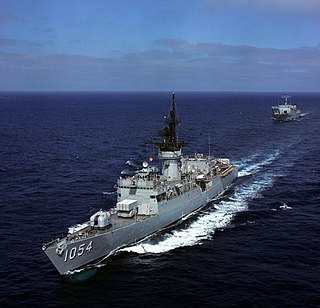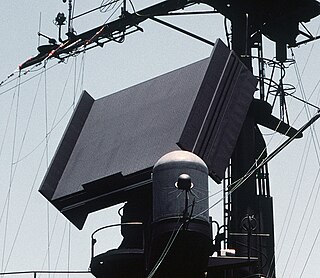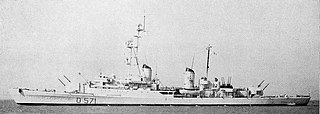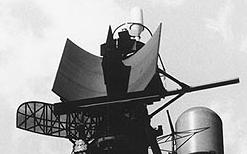
The Charles F. Adams class is a ship class of 29 guided-missile destroyers (DDG) built between 1958 and 1967. Twenty-three were built for the United States Navy, three for the Royal Australian Navy, and three for the West German Bundesmarine. The design of these ships was based on that of Forrest Sherman-class destroyers, but the Charles F. Adams class were the first class designed to serve as guided-missile destroyers. 19 feet (5.8 m) of length was added to the center of the design of the Forrest Sherman class to carry the ASROC launcher. The Charles F. Adams-class were the last steam turbine-powered destroyers built for the U.S. Navy. Starting with the succeeding Spruance-class, all U.S. Navy destroyers have been powered by gas turbines. Some of the U.S. Charles F. Adams class served during the blockade of Cuba in 1962 and during the Vietnam War; those of the Royal Australian Navy served during the Vietnam War and Gulf War.
The Andrea Doria class were helicopter cruisers of the Italian Navy. Italy's first major new designs of the post–World War II era, these ships were primarily designed for anti-submarine warfare tasks. Initially planned for three ships, the two ships that were constructed, Andrea Doria and Caio Duilio served until 1991 in both active and training capacities. The Andrea Doria class formed the basis for the larger Vittorio Veneto that followed them.

Destroyer leader (DL) was the United States Navy designation for large destroyers from 9 February 1951 through the early years of the Cold War. United States ships with hull classification symbol DL were officially frigates from 1 January 1955 until 1975. The smaller destroyer leaders were reclassified as destroyers and the larger as cruisers by the United States Navy 1975 ship reclassification so destroyer escorts could be reclassified as frigates (FF) in conformance with international usage of the term.

The Cheng Kung-class frigates are eight guided-missile frigates in service in the Republic of China Navy (ROCN). They are based upon the U.S. Oliver Hazard Perry class and built by China Shipbuilding Corporation in Kaohsiung, Taiwan under license throughout the 1990s as part of the Kuang Hua I project. These frigates served as the mainstay of the ROCN's area air defense capability prior to the acquisition of the Keelung (Kidd)-class destroyers in 2005. They are designated with the hull classification PFG rather than FFG used by the Oliver Hazard Perry class.

Leahy-class cruisers were a class of guided-missile cruisers built for the United States Navy. They were originally designated as Destroyer Leaders (DLG), but in the 1975 cruiser realignment they were reclassified as guided-missile cruisers (CG).

The Abukuma-class destroyer escort is the general-purpose destroyer escort of the Japan Maritime Self-Defense Force. It is the successor of the earlier Yūbari class.

The AN/SPS-48 is a US naval electronically scanned array, air search three-dimensional radar system manufactured by ITT Exelis and deployed in the 1960s as the primary air search sensor for anti-aircraft warships. The deployment of the AN/SPY-1 and the end of the Cold War led to the decommissioning of many such ships, and many of these vessel's AN/SPS-48 sets were reused on aircraft carriers and amphibious ships where it is used to direct targets for air defense systems such as the Sea Sparrow and RIM-116 SAM missiles. Existing sets are being modernized under the ROAR program to AN/SPS-48G standard for better reliability and usability.

USS Gray (FF-1054) was a United States Navy Knox-class frigate. She was named for Marine Corps Sergeant Ross F. Gray, who was a posthumous recipient of the Medal of Honor.

The Brooke class was a United States Navy frigate class based on the design of the Garcia class, but with the addition of the Tartar Guided Missile System. The first unit was commissioned in 1966 and the final sixth unit was decommissioned in 1989.

The AN/SPS-40 is a United States Navy two-dimensional, long range air search radar that is capable of providing contact bearing and range. It was replaced by the AN/SPS-49 on newer ships and on ships that received the New Threat Upgrade.

The AN/SPS-52 is a United States Navy long-range air search 3D radar that is capable of providing contact bearing, range and altitude. It was used on Baleares and Brooke-class frigates, Charles F. Adams and Hatakaze-class destroyers, Tarawa and Wasp-class amphibious assault ships, Galveston, and Providence-class cruisers and other ships. It was replaced by the AN/SPS-48 on newer ships and ships that received upgrades. The antenna is mechanically rotated for azimuth but electronically scanned for elevation.

Alpino was a Alpino-class frigate operated by the Italian Navy during the Cold War. Launched in 1967, the vessel was optimised for anti-submarine warfare based on two Agusta-Bell AB.204 helicopters protected by a telescopic hangar and a variable depth sonar. It was also the first frigate to use gas turbines, in a combined diesel and gas (CODAG) arrangement. In 1973, the frigate undertook the longest continuous voyage of an Italian naval ship, covering 7,315 nautical miles, and continued to serve in the anti-submarine role until 1996, by which time the helicopters had been replaced by the more capable Agusta-Bell AB-212ASW and the variable depth sonar taken out of service. In 1997, the ship was recommissioned as a support ship for mine warfare, at the same time as the ability to operate one of the helicopters was removed. The frigate was decommissioned in 2006.

AN/SPS-6 is a two-dimensional radar manufactured by Bendix and Westinghouse Electric. It was used by the US Navy as a first-generation air-search radar after World War II, and was widely exported to allies. In addition, the improved AN/SPS-12 is the derivative types developed in other countries.

The Centauro class consisted of four frigates built for the Italian Navy during the 1950s. They entered service in 1957, with the last one being stricken in 1985.

AN/SPS-10 is a two-dimensional radar manufactured by Raytheon Technologies. It was used by the US Navy as a surface-search radar after World War II, and was equipped aboard naval ships during the Cold War. Variants include AN/SPS-10B, AN-SPS/10E and AN/SPS-10F.

AN/SPS-39 is a three-dimensional radar was manufactured by Hughes Aircraft Company. It was used by the US Navy as a parabolic-cylinder reflector antenna after World War II, and was equipped aboard naval ships during the Cold War. It was mass-produced based on AN/SPS-26, and was also the first 3D radar deployed by the US Navy in the fleet. It later evolved into an improved AN/SPS-52.

Centauro was the lead ship of the her class of four frigates built for the Italian Navy in the 1950s.

Canopo was one of four Centauro-class frigates built for the Italian Navy in the 1950s.

Castore was one of four Centauro-class frigates built for the Italian Navy in the 1950s.

Cigno was one of four Centauro-class frigates built for the Italian Navy in the 1950s.

















